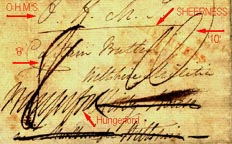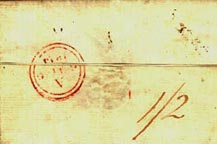These letters graciously have been shared with the Victorian Web by Eunice and Ron Shanahan; they have been taken from their website. The letters give an insight into the daily lives and concerns of 'ordinary' people without whom history would not exist. The letters are a wonderful example of how much history may be gleaned from such sources.
 Following on from the
letters written by Wellington's officers
in the Peninsular War, and the letter written concerning Napoleon, I have collected
more letters with military connections. This letter dated July 4, 1814 Sheerness,
is from Lt Miller of the Wiltshire Regiment, who had handwritten on the envelope
"O.H.M.S." It is addressed to Captain Butler, Wiltshire Militia, Kirby
House, Marlborough, Wiltshire, and has been readdressed to somewhere illegible
but looks like Hungerford. That is the town next to Marlborough on the Great
Western Road out from London.
Following on from the
letters written by Wellington's officers
in the Peninsular War, and the letter written concerning Napoleon, I have collected
more letters with military connections. This letter dated July 4, 1814 Sheerness,
is from Lt Miller of the Wiltshire Regiment, who had handwritten on the envelope
"O.H.M.S." It is addressed to Captain Butler, Wiltshire Militia, Kirby
House, Marlborough, Wiltshire, and has been readdressed to somewhere illegible
but looks like Hungerford. That is the town next to Marlborough on the Great
Western Road out from London.
It has a faint SHEERNESS town mileage mark in red - the mileage is not legible, but Alan W Robertson's book Great Britain Post Roads, Post Towns and Postal Rates 1635-1839 lists the mileage from London as 46. On the back of the letter it has a poorly-struck double-ring morning duty stamp in red for JY 6, 1814 - two days after it was dated. This would have been applied in London, and I am surprised that there is no postmark to show when it was received in Marlborough, and then re-directed to Hungerford.
 There are three charge
marks on the letter, 10 (for Sheerness to Marlborough - a distance of 120 miles,
and that was the rate for posting a single letter over a distance between 120-170
miles during the period 1812-1839); '8' ( presumably for the readdressed charge
to Hungerford - but as this is only 10 miles away, the cost should only have
been 4d not 8d!), and a red 1/2d on the back of the letter.
There are three charge
marks on the letter, 10 (for Sheerness to Marlborough - a distance of 120 miles,
and that was the rate for posting a single letter over a distance between 120-170
miles during the period 1812-1839); '8' ( presumably for the readdressed charge
to Hungerford - but as this is only 10 miles away, the cost should only have
been 4d not 8d!), and a red 1/2d on the back of the letter.
This does not seem to apply to any distance or weight for the letter. My suggestion as to the relevance of this charge would be that it had been entered as a total to be collected by the Post Office, if there had been more than one letter that day for Capt. Butler.
Sheerness was a naval seaport and Garrison town situated on the Isle of Sheppey in the Thames estuary, which had developed from a small fort built here by Charles II. At this time, 1814, it was used primarily to supply food and provisions, and make repairs to naval vessels, also for the embarkation/disembarkation of fighting troops.
The contents of the letter interest me - and not only because I came from Wiltshire, and know the places mentioned.
'Dear Sir,
The Superintendents of Military Accounts have again written to Captain Tompson, requesting to know the cause you have not forwarded the document enclosed you by Captn. Tompson, to their office.
The documents in question were sent to you by Captn. Tompson on the 29th Ulto. for your signature, and that you may forward them to the Superintendents for Military Accompts - I have no doubt on the receipt of this you will write to Captn. T. or myself, saying, you received the papers alluded to and if you have sent them off.
I perceive you have left the Return with me for our Lodging Money in Scotland, have the goodness to say what you would wish to be done with it.
Young's Marching Money has been disallowed, which has thrown him considerably in debt, I shall be glad if you will give directions in what way it must be recovered - I don't expect he will submit to stoppages, unless by the investigation, and order of a Court Martial - he will shortly have to receive his Renewal Guinea, which will enable him to pay part, and I shall stop his arrears for the remainder.
I was in London a few days ago, and was informed by Mr. Frazer (The Agent) that the Regt. was fully expected to be disembodied on the 24th Septr.
With Compts to Mrs Butler,
I remain Dear Sir,
yours truly
L. Miller. Lt. Wilts Regt."
Further information.
- The Militia was a branch of the British military service formerly raised by several Counties usually by voluntary enlistment. The Hutchinson Encyclopedia defines the Militia as
a body of civilian soldiers, usually with some military training, who are on call in emergencies, distinct from professional soldiers. After the Restoration of the Monarchy, the militia fell into neglect, but it was reorganised in 1757, and relied upon for home defence during the French wars. In the 19th century it extended its activities abroad, serving in the Peninsular, Crimean and South African wars. In 1852 it adopted a volunteer status and in 1908 was merged with the Territorial Army and the Special Reserve forces to supplement the regular army, and ceased to exist as a separate force.
I am indebted to Paul Vivash for the following information (October 2000)
The background to the militia men goes back to the Militia Act of 1757 which was passed following an outbreak of war with France. Taking Wiltshire: the Secretary at War instructed the Lord Lieutenant of Wiltshire to raise a regiment of 800 men. Every parish was required to raise a certain number between the ages of 18 and 45. There were exemptions and a man could pay a fine of £10 to the parish officials who would find a replacement.
The men served for 3 years, later extended to 5, and had to carry out 28 days military training each year. The militiamen were used in aiding the magistrates in civil disturbances (as in the case of the Swing Riots of 1830), suppressing smuggling and helping to apprehend deserters.
The officers (such as the ones you quote) were local magnates who held or were heirs to estates and whose annual income amounted to £400 for a colonel down to £50 for an ensign.
The Wiltshire Regiment was first embodied in 1759 with 10 companies assembled at Bedwyn, Bradford upon Avon, Chippenham, Devizes, Hindon, Marlborough, Salisbury, Swindon, Warminster and Wilton.
The records are held in the Public Records Office and comprise mostly marching orders and muster and volunteer rolls. The first marching orders WO5/91 were for an assembly at Devizes and a march to Winchester in June 1759.
The combined muster rolls and pay books for the 1st Wilts start with WO13/2252 for 1798 and go through to 1815 WO13/2269. There is a supplementary roll 1802-1816 WO13/2566. The 2nd Wilts rolls from 1798-1805 are WO13/2281-85 and the local volunteer roll is WO13/4584-8.
I know of no book which deals wholly with the Militia but there is a History of the Wiltshire Regiment written by Colonel Kendrick which has some details.
Some friends in Wiltshire went to the Record Office for me, and came up with this information: 1st Battalion formed in 1756 (62nd Regt of Foot). In 1758 four companies were drafted to the Royal Navy to serve as Marines. Sailed for St Lawrence, Canada. Won the first honours for the Regiment at Louisburg 1758. The other Company went out to the West Indies. The other half of the Regiment were sent to Ireland 1758. Given the title "the Wiltshire Regiment" in 1782. Stationed in Trowbridge for a short time in 1783. Second Battalion formed in 1799.
On the advice of the CRO in Trowbridge, they wrote to the Museum in Salisbury, and received this reply.
2nd November 2000
Re Lt Miller and Capt Butler
Thank you for your letter of 27 October concerning the two officers listed above. The local Wiltshire Militia was formed in 1808 and consisted of five Regiments. This, together with the Regular Militia was the equivalent of today's Territorial Army. It is to these Units that the letter that you have refers. The Wiltshire Regiment (62nd and 99th) was formed as part of the regular army under the Cardwell Reforms at 1881.
Regrettably we have no records of these earlier units and I am therefore unable to help you. Your friends have far more information from the PRO than we have.
Yours sincerely
Major (Retd) P J Ball
For Manager/Curator
- The Renewal Guinea was I believe the amount paid to the volunteer - it was worth £1/1/-d and this does not seem much to solve his debt problems!
- Marching Money - the Webster's dictionary has this definition: The additional pay of officers or soldiers when his Regiment is marching.
- This letter was written six months after the battle of Toulouse, in which Napoleon was defeated, and abdicated. He was then exiled to Elba, and it was thought that this was the end of the French threat to Europe, so many of he military units were disbanded - or as the writer says - "disembodied".
Last modified 13 December 2002
